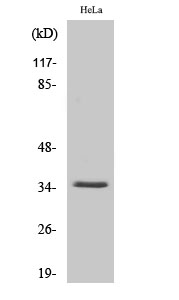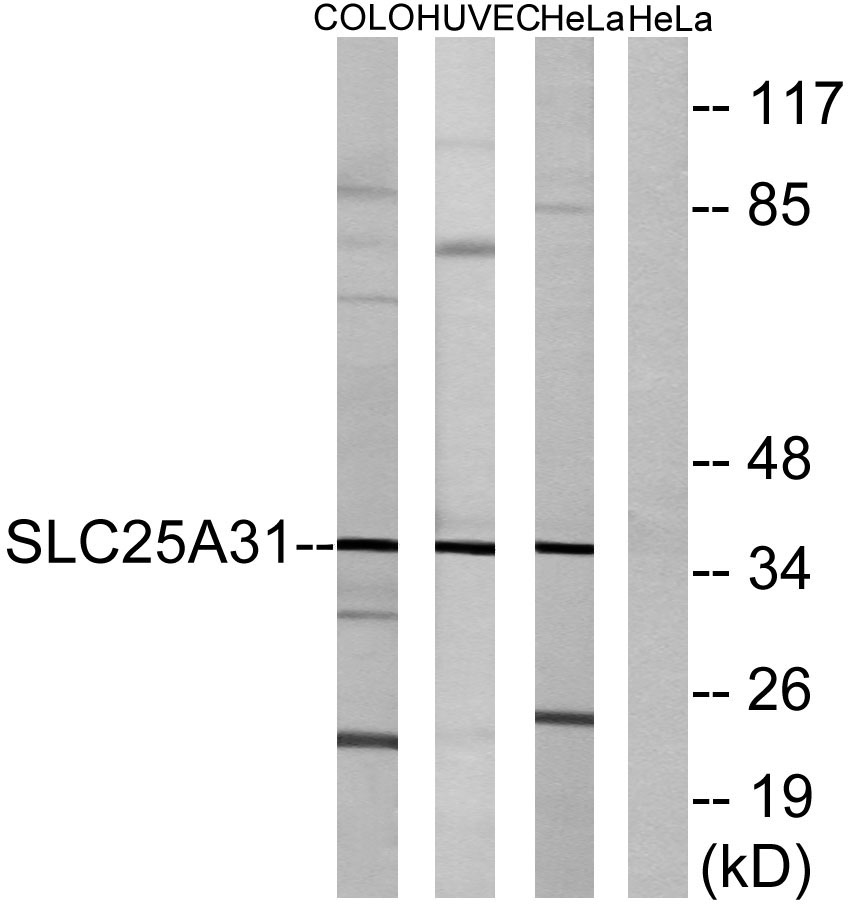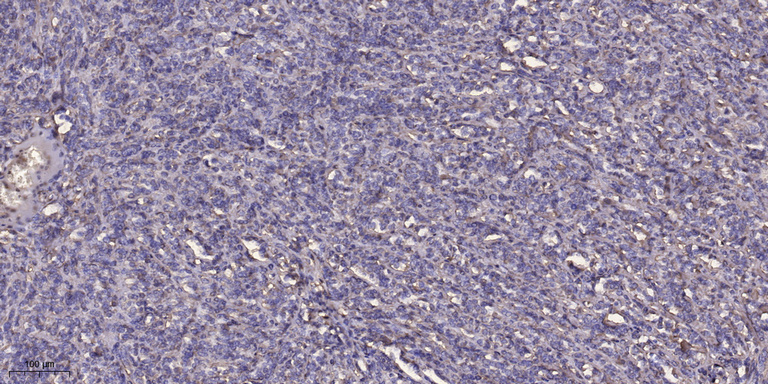ANT4 Polyclonal Antibody
- Catalog No.:YT0242
- Applications:WB;IHC;IF;ELISA
- Reactivity:Human;Mouse
- Target:
- ANT4
- Fields:
- >>Calcium signaling pathway;>>cGMP-PKG signaling pathway;>>Necroptosis;>>Cellular senescence;>>Neutrophil extracellular trap formation;>>Alzheimer disease;>>Parkinson disease;>>Huntington disease;>>Spinocerebellar ataxia;>>Prion disease;>>Pathways of neurodegeneration - multiple diseases;>>Influenza A;>>Human T-cell leukemia virus 1 infection;>>Chemical carcinogenesis - reactive oxygen species;>>Diabetic cardiomyopathy
- Gene Name:
- SLC25A31
- Protein Name:
- ADP/ATP translocase 4
- Human Gene Id:
- 83447
- Human Swiss Prot No:
- Q9H0C2
- Mouse Gene Id:
- 73333
- Mouse Swiss Prot No:
- Q3V132
- Immunogen:
- The antiserum was produced against synthesized peptide derived from human SLC25A31. AA range:131-180
- Specificity:
- ANT4 Polyclonal Antibody detects endogenous levels of ANT4 protein.
- Formulation:
- Liquid in PBS containing 50% glycerol, 0.5% BSA and 0.02% sodium azide.
- Source:
- Polyclonal, Rabbit,IgG
- Dilution:
- WB 1:500 - 1:2000. IHC 1:100 - 1:300. IF 1:200 - 1:1000. ELISA: 1:40000. Not yet tested in other applications.
- Purification:
- The antibody was affinity-purified from rabbit antiserum by affinity-chromatography using epitope-specific immunogen.
- Concentration:
- 1 mg/ml
- Storage Stability:
- -15°C to -25°C/1 year(Do not lower than -25°C)
- Other Name:
- SLC25A31;AAC4;ANT4;SFEC;ADP/ATP translocase 4;ADP;ATP carrier protein 4;Adenine nucleotide translocator 4;ANT 4;Solute carrier family 25 member 31;Sperm flagellar energy carrier protein
- Observed Band(KD):
- 35kD
- Background:
- The protein encoded by this gene is a member of the ADP/ATP carrier family of proteins that exchange cytosolic ADP for matrix ATP in the mitochondria. Cells over-expressing this gene have been shown to display an anti-apoptotic phenotype. This protein is also thought to play a role in spermatogenesis, where it is believed to associate with a part of the flagellar cytoskeleton and with glycolytic enzymes. Male mice with mutations in the mouse ortholog of this gene are sterile and spermatocytes display an early meiotic arrest phenotype. Alternative splicing results in multiple transcript variants encoding different isoforms. [provided by RefSeq, Jan 2016],
- Function:
- function:Catalyzes the exchange of ADP and ATP across the mitochondrial inner membrane. May serve to mediate energy generating and energy consuming processes in the distal flagellum, possibly as a nucleotide shuttle between flagellar glycolysis, protein phosphorylation and mechanisms of motility.,similarity:Belongs to the mitochondrial carrier family.,similarity:Contains 3 Solcar repeats.,subcellular location:In sperm flagellum this protein is located in the fibrous sheath, a non-mitochondrial region.,tissue specificity:Expressed in brain, liver, sperm and testis.,
- Subcellular Location:
- Mitochondrion inner membrane ; Multi-pass membrane protein . Membrane ; Multi-pass membrane protein . Cell projection, cilium, flagellum membrane ; Multi-pass membrane protein . In sperm flagellum this protein is located in the fibrous sheath, a non-mitochondrial region (PubMed:17137571). May localize to non-mitochondrial membranes (PubMed:27641616). .
- Expression:
- Expressed in brain, liver, sperm and testis (PubMed:15670820, PubMed:17137571). In testis, expressed at higher level in spermatocytes, while it is expressed at lower level in spermatogonial cells (PubMed:17681941). Expressed in erythrocytes (at protein level) (PubMed:27641616).
- June 19-2018
- WESTERN IMMUNOBLOTTING PROTOCOL
- June 19-2018
- IMMUNOHISTOCHEMISTRY-PARAFFIN PROTOCOL
- June 19-2018
- IMMUNOFLUORESCENCE PROTOCOL
- September 08-2020
- FLOW-CYTOMEYRT-PROTOCOL
- May 20-2022
- Cell-Based ELISA│解您多样本WB检测之困扰
- July 13-2018
- CELL-BASED-ELISA-PROTOCOL-FOR-ACETYL-PROTEIN
- July 13-2018
- CELL-BASED-ELISA-PROTOCOL-FOR-PHOSPHO-PROTEIN
- July 13-2018
- Antibody-FAQs
- Products Images

- Western Blot analysis of various cells using ANT4 Polyclonal Antibody diluted at 1:500

- Western blot analysis of lysates from HeLa, HUVEC, and COLO cells, using SLC25A31 Antibody. The lane on the right is blocked with the synthesized peptide.

- Western blot analysis of the lysates from K562 cells using SLC25A31 antibody.

- Immunohistochemical analysis of paraffin-embedded human Colon cancer. 1, Antibody was diluted at 1:200(4° overnight). 2, Tris-EDTA,pH9.0 was used for antigen retrieval. 3,Secondary antibody was diluted at 1:200(room temperature, 45min).



